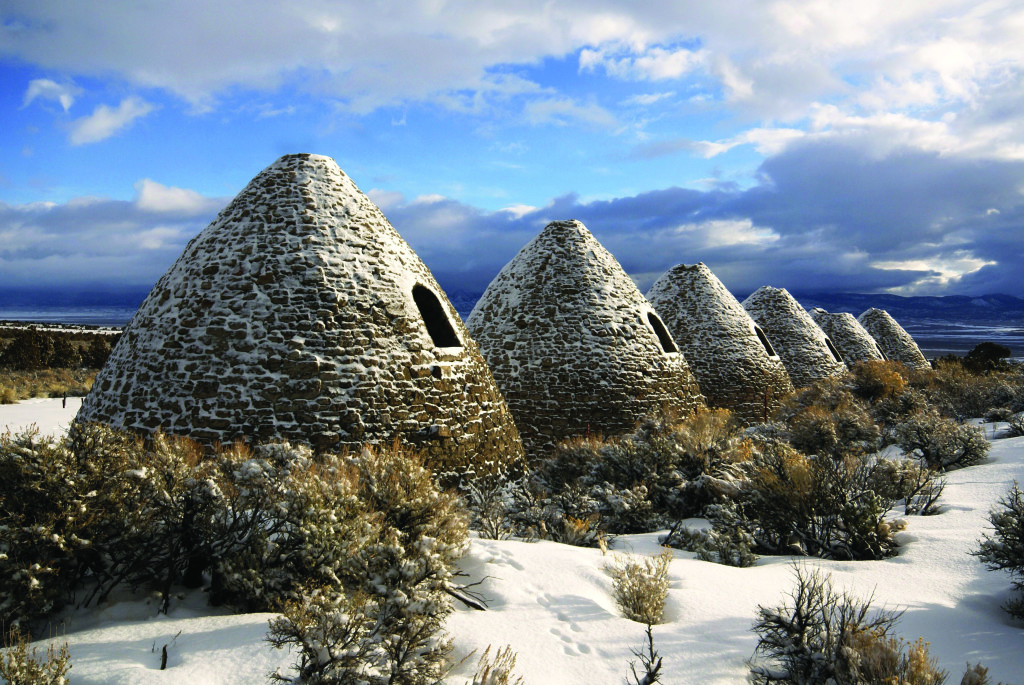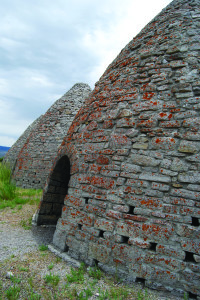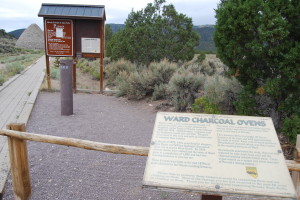Ward Charcoal Ovens
May – June 2014
Desert beehives protect a slice of mining history.
BY ALLEN WOOLDRIDGE | May/June 2014

In 1872, two brothers traveled from Pioche to the railroad town of Toano in Elko County, looking for lost oxen along Willow Creek. The brothers stumbled upon silver ore, triggering a mining boom that was characteristic of early Nevada.
Virtually overnight, the mountains around Willow Creek were flooded with miners in search of their own rich ore. Seeing the potential for the area, the Martin and White Company of San Francisco purchased several claims and built smelters to process the ore in the new Ward Mining District. The smelters would work well in the area, but were worthless without a hot-burning fuel to keep them running.
ANATOMY OF A CHARCOAL OVEN

Their beehive shape—a relatively new design—was more efficient than older designs, creating a better end product. Each oven cooked 35 cords of wood for 12 days to create the perfect batch of charcoal. The process involved loading the oven with wood, lighting the wood on fire, and sealing the entryways with large cast-iron doors and mortaring them closed. Three rows of vents were systematically opened and closed to control the amount of oxygen that was introduced to the fire. This controlled burn allowed other components of wood to burn off and leave a carbon charcoal core.To supply the smelter with quality fuel, six charcoal ovens were commissioned along Willow Creek. Blocks made of tertiary volcanic and quartz latite tuff were chipped out of nearby mountains by hand, and two small kilns were built about 100 yards west of the ovens to create the mortar. The ovens were 30 feet high and 27 feet in diameter, with a wall thickness of 20 inches. These six ovens produced charcoal used within the smelters to extract minerals from the ore. Charcoal was used due to its ability to burn at a higher temperature and longer than raw wood.
When burning was complete, the ovens were completely closed off and allowed to cool for a day to make sure the fire was completely out. Charcoal was emptied and then the oven had to be relined with mortar before loading with wood again and the process repeated. The ovens made about 600 bushels of charcoal that was loaded and taken by wagon to the smelter, just a short distance away.
SHORT-LIVED SMELTING SUCCESS
In only three short years, the charcoal ovens were shut down as a new fuel source—petroleum coke—made its way west on railroad cars. This new product—a solid carbon that resulted from the heating of coal—was cheaper and more efficient at firing the smelters. Lumber was also becoming harder to find and more expensive to transport.
As the successful mining began to taper off, most of the land within 35 miles was clear-cut of trees to be used in the ovens, mine bracing, and other uses. Most mining claims busted and miners left in search of new claims to work. The new Taylor mine—located directly east across the valley from Ward—attracted many of these tough-luck miners. Resource issues and a decrease in ore quality caused miners to leave the town of Ward, which officially died in 1888 when the post office closed. However, the ovens did not go unused; they acted as shelters in inclement weather and had a reputation of being a hideout for stagecoach bandits.
THE OVENS TODAY
The ovens are a living link to Nevada’s unique history. Ward Charcoal Ovens State Historic Park was officially designated in 1994 and continues to both protect the ovens and educate visitors about Nevada and White Pine County’s rich mining history. Visitors can explore these 140-year-old relics, getting an up-close look at the remarkable skill used to create them.

Trails within the park provide hiking and biking along Willow Creek where the mining explosion began. The overlook trail provides a bird’s-eye view of the ovens and Steptoe Valley. The town site of Ward is also still visible. Sections of the buildings were dismantled and used to create buildings in new boomtowns, but there are some foundations intact. The Ward Cemetery is located just off the road and serves as a reminder of the difficulties of mining life. Many of the grave markers are those of children and families that died within a short time of each other, suggesting disease.
The park has day-use facilities and a recently renovated campground with shade structures, fire rings, grills, water, and vault toilets. This new campground is a great basecamp location for recreation. The day use facilities are great way to get off the highway, enjoy a shady picnic spot along the creek, and relax while fishing for creek rainbow and brook trout.
PLAN YOUR TRIP
Ward Charcoal Ovens State Historic Park
P.O. Box 151761
Ely, NV 89315
parks.nv.gov, 775-289-1693
